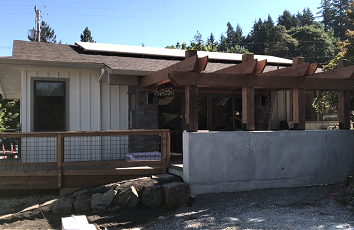Related News
Related News
-
Sustainability Snapshot - Celebrating Energy Efficiency Projects in the Community
Sustainability Snapshops highlight impactful projects completed by EWEB's Customer Solutions department, as a way to celebrate the meaningful work happening behind the scenes.
Find Out More -
EWEB secures $2.5 billion of reliable, affordable, carbon-free energy for customers
The new contract with EWEB’s largest energy supplier, the Bonneville Power Administration, forms the foundation of a diverse energy portfolio.
Find Out More -
Women in STEM: Meet the Hydro Project Engineer Building Habitat for Salmon
EWEB Engineer Associate Val Chang found her way to the McKenzie River from Los Angeles, inspired by heritage trips to the waters of Taiwan and key mentors along the way.
Find Out More -
Public Power Week Poster Contest Winners 2025
The results are in! View the winning posters from EWEB's 2025 Public Power Week Poster Contest.
Find Out More -
EWEB Hometown Heroes compete internationally
Out of 290 teams from 14 different countries, EWEB's Lineman Rodeo team places in the top third of competitors.
Find Out More -
Vote for your favorite Public Power Week Posters
The top five submittals will receive awards. Help us pick the winners.
Find Out More -
Electric Projects underway in North & South Eugene
Underground lines and disaster-resilient power poles are part of EWEB’s infrastructure upgrade near Eugene’s largest natural resource area.
Find Out More -
The Bonneville Power Administration Rate Change and Your EWEB Bill
BPA’s finalized rate increase is smaller than projected, and EWEB’s pass-through adjustment effective October 1, 2025 will now be 2.7% for residential customers—down from the anticipated 4%.
Find Out More -
EWEB completes helicopter installation of salmon habitat features
EWEB adds downed trees and 2,000 tons of gravel to the Uupper McKenzie River below Tamolitch Falls to improve spawning habitat.
Find Out More -
Court rules in favor of EWEB in Carmen-Smith litigation
The U.S. District Court in Eugene has granted EWEB's motion to dismiss a lawsuit brought under the Endangered Species Act pertaining to fish passage at EWEB’s Trail Bridge Dam. The favorable ruling clears the way for EWEB to continue advancing towards implementation of permanent fish passage at the dam.
Find Out More -
EWEB proposes modified plan for permanent fish passage at Trail Bridge Dam
After eight months of extensive collaboration and analysis with scientific experts at two federal regulatory agencies, EWEB is proposing an improved plan to build permanent fish passage facilities at Trail Bridge Dam on the McKenzie River.
Find Out More -
Sustainability Snapshot - Ideal Steel July 2025
Our second Sustainability Snapshop highlights a project where EWEB helped a local industrial warehouse upgrade over 1,000 flourescent lights to new efficient LEDs.
Find Out More -
EWEB prepares for wildfire season with risk mitigation measures
EWEB is building a more resilient electric system to weather various types of disasters, from wildfire to winter storms.
Find Out More -
EWEB, Lane County host open house to gather feedback for “Leaburg Transportation Alternatives Analysis”
“What is the Future of the Leaburg Dam Bridge?” open house exhibit on display at Lloyd Knox Park Visitor Pavilion through July 25
Find Out More -
Improving habitat resiliency throughout the Upper McKenzie
Environmental Responsibility is a core guiding value for EWEB decision-making. This summer, EWEB continues its commitment to environmental stewardship with a robust slate of habitat enhancement updates throughout the upper McKenzie River, across the footprint of the Carmen-Smith Hydroelectric Project.
Find Out More - Show More
Check out this super-efficient home on the BRING Home and Garden Tour
September 06, 2017

Want to save energy, reduce your carbon footprint, lower your utility bills and improve the comfort of your home? We can help!
Today, home owners and builders have multiple options for designing and building high-performance homes or renovating existing homes. From energy efficient windows, to insulation, air sealing, heating and cooling systems, lighting and appliances—making the right choices will greatly reduce your energy use.
EWEB supports builders and home owners with rebates and loans for energy efficiency upgrades. We offer additional rebates for new homes that meet certain efficiency standards, such as the Energy Trust of Oregon's Energy Performance Score (EPS).
EPS-rated homes are built above the current statewide energy codes. The score is similar to a miles-per-gallon metric—it allows you to compare the energy use of different homes, along with the estimated utility costs, and carbon impact.
You can see an example of an EPS-rated high-performance home on the 2017 BRING Home and Garden Tour, Sunday, Sept. 17, at Site 9. We partnered with the builder to help the homeowners achieve their dream of a modern, durable, super-efficient home. With high-performance insulation, air sealing, efficient mechanical systems, plus a solar photovoltaic system, this home earned an EPS of 10 on scale of zero to 200+, where zero is the most efficient. It's estimated this home will cost less than $120 per year to operate. You can view two additional high-performance homes with Energy Performance Scores at Sites 1 and 6 on the tour.
Check out this video to learn more about this home and how you can save energy, reduce your carbon footprint, and lower the utility bills for your new construction or home renovation project by applying a few simple principles of high-performance homes.
Electric or gas?
If you're building new or remodeling your home, you may be weighing fuel heating options. Because buildings in EWEB's service territory are powered by 90 percent renewable electricity, efficient electric heating and cooling systems are a good option for lowering your carbon footprint. For example, a ductless heat pump will reduce carbon dioxide emissions by 95 percent when compared to a typical natural gas-powered heating system.
Look for us on the BRING Home and Garden Tour (Site 9), where EWEB experts will be on-hand from 11 a.m. to 1 p.m. to talk about different energy saving technologies and the carbon benefits of high-efficiency electric systems.

